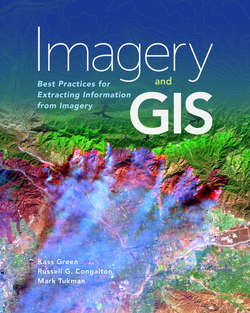Читать книгу Imagery and GIS - Kass Green - Страница 84
На сайте Литреса книга снята с продажи.
Thermal Imagery — All Spatial Resolutions
ОглавлениеThermal sensors are a special type of multispectral scanner that sense only in the thermal wavelengths. Like radar imagery, thermal imagery is usually rendered in grayscale, with warmer areas represented by lighter shades and cooler areas in darker shades. The image can also be pseudocolored, with blue shades representing cool and red shades warm. Thermal sensors measure in wavelengths of electromagnetic energy that are naturally emitted from objects as a direct result of the objects’ temperatures. Thermal sensors do not measure reflected energy, but rather emitted energy, and therefore can be acquired any time of day or night. Because of issues caused by the atmosphere, thermal imagery is collected with wavelengths of either 3 to 5 microns, 8 to 14 microns, or both.
Thermal imaging sensors can be flown as part of a multispectral scanner or in conjunction with one. For example, the Landsat TM sensor (on Landsats 4, 5, and 7) has a thermal band of 10.40 to 12.50 microns in addition to sensing in the visible, near-infrared, and middle-infrared wavelengths. The thermal band has a spatial resolution of 120 meters on Landsats 4 and 5 and 60 meters on Landsat 7. Landsat 8 also has a thermal sensor, called the Thermal Infrared Sensor (TIRS), which flies on the same platform as the Operational Land Imager (OLI). The OLI senses in the visible, near-infrared, and middle-infrared wavelengths. TIRS has two thermal bands (10.6 to 11.2 and 11.5 to 12.5 microns) and a spatial resolution of 100 meters. All Landsat imagery including the thermal data is freely available for download from a number of USGS websites including Earth Explorer (http://earthexplorer.usgs.gov), Global Visualization Viewer (GloVis) (http://glovis.usgs.gov/next/), and Landsat Look Viewer (http://landsatlook.usgs.gov).
Similarly, the Moderate Resolution Imaging Spectroradiometer (MODIS) senses in 36 bands at varying spatial resolutions depending on the wavelength. There are six thermal bands; four in the 3- to 5-micron range and two in the 10- to 12-micron range. The spatial resolution of the MODIS thermal imagery is 1 km. Additional information about the acquisition of MODIS imagery can be found at http://modis.gsfc.nasa.gov. Finally, the AVHRR also senses in the thermal wavelengths including one in the 3- to 5-micron range and two in the 10- to 12-micron range. AVHRR imagery is provided free by NOAA through the Comprehensive Large Array-Data Stewardship System at www.class.ncdc.noaa.gov/.
Thermal sensors on aircraft can also be a component of a multispectral scanner. However, it is more common for the sensor to be a thermal sensor with multiple wavelengths being collected just in the thermal range. These sensors have been flown on fixed-wing aircraft and helicopters and most recently on UAS’s, otherwise known as drones. There are many applications for thermal imagery flown on an aircraft. Most notably, these applications include forest fire detection and measurement of heat loss from buildings. The US Forest Service and NASA have cooperated extensively on detecting forest fires using thermal imagery and have put thermal sensors on airplanes, helicopters, and most recently on UASs. Many utility companies employ thermal sensors to detect heat loss from houses to demonstrate where increased insulation or replacement of windows could significantly reduce heating costs. Other applications for thermal data include disaster mapping such as volcanic activity and sensing of large mammals (bears, moose, elk, etc.).
